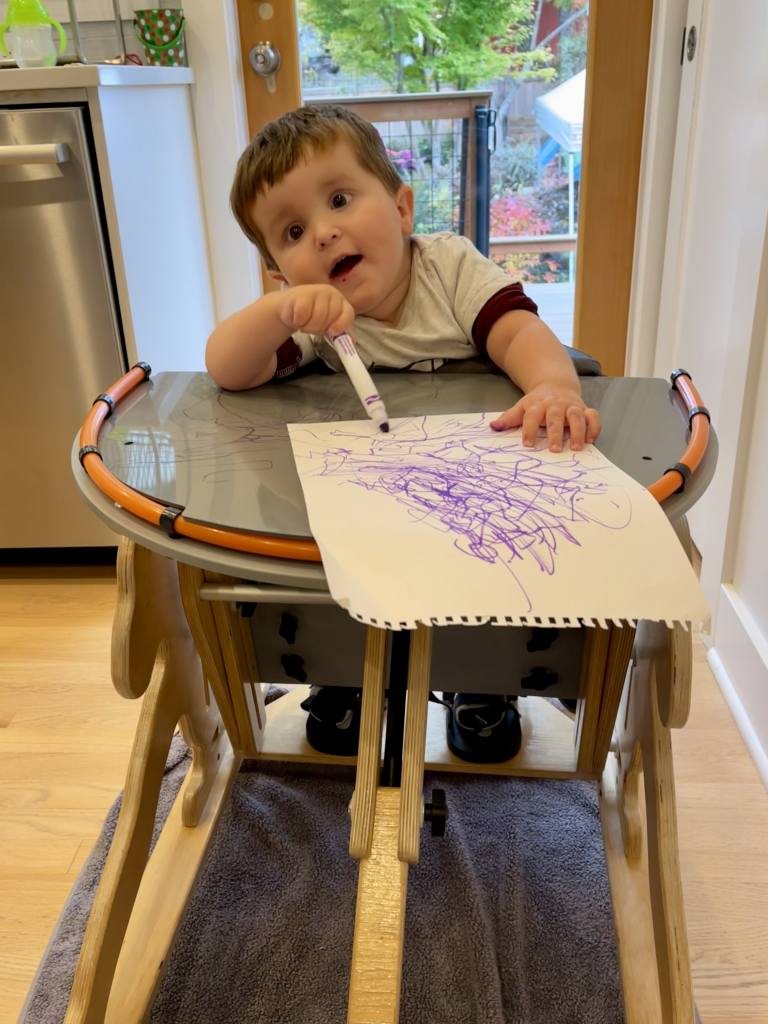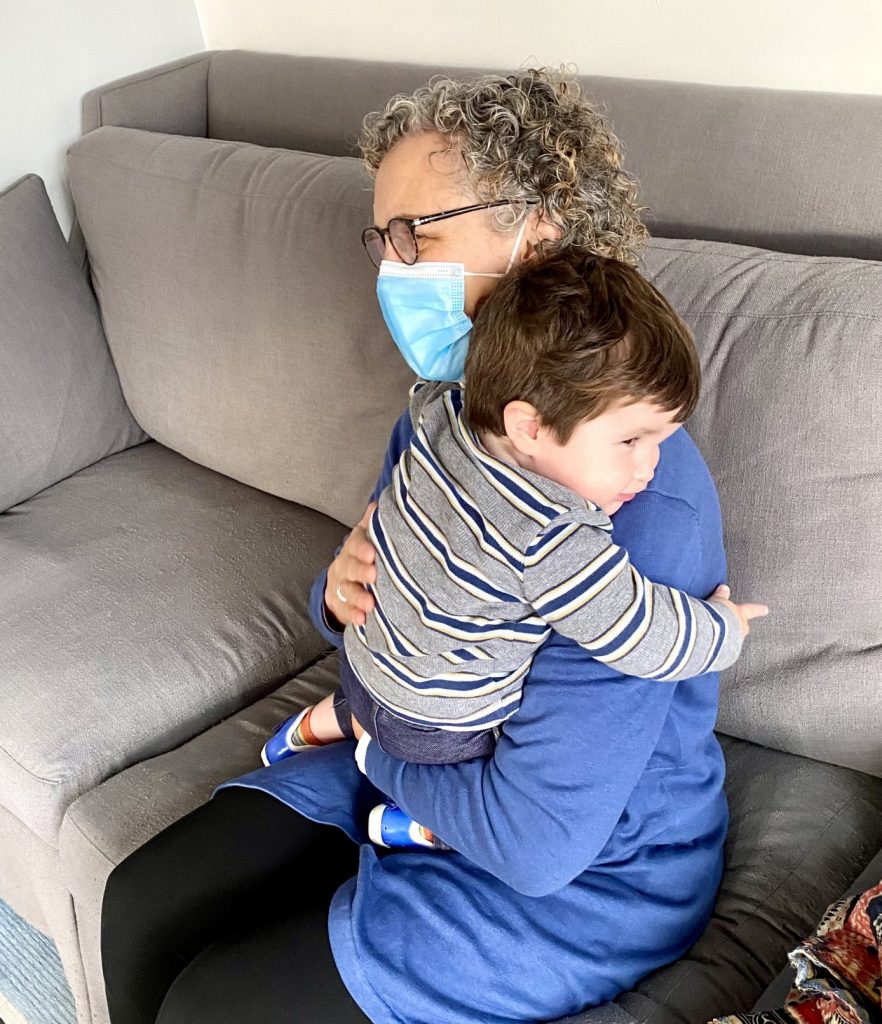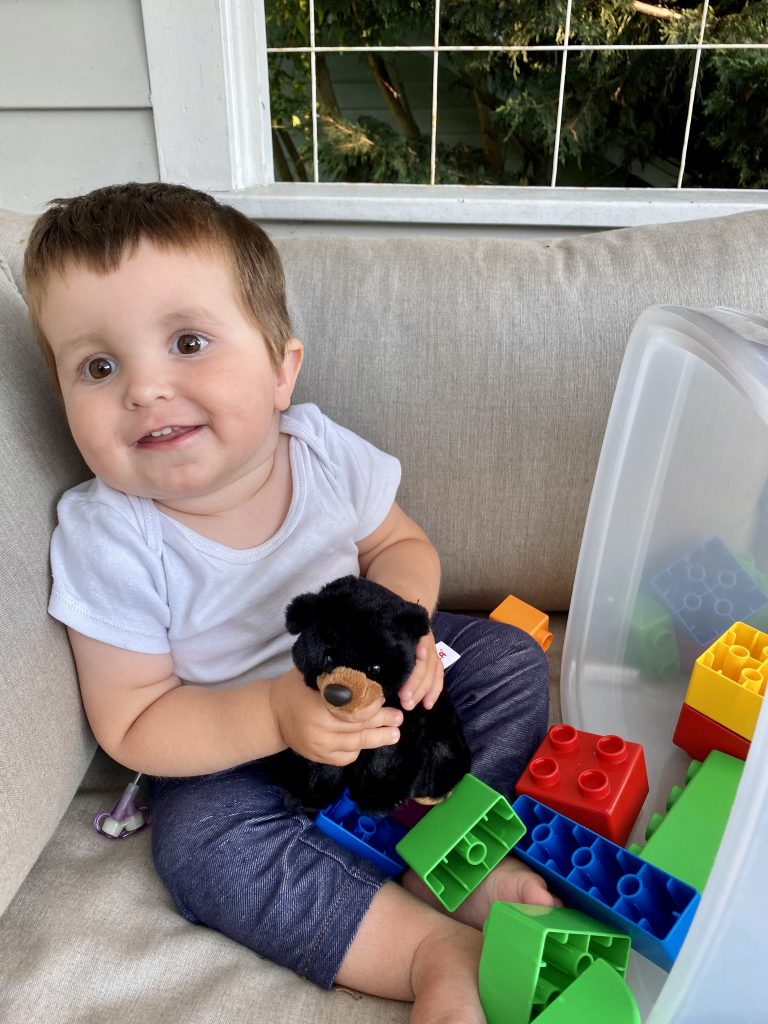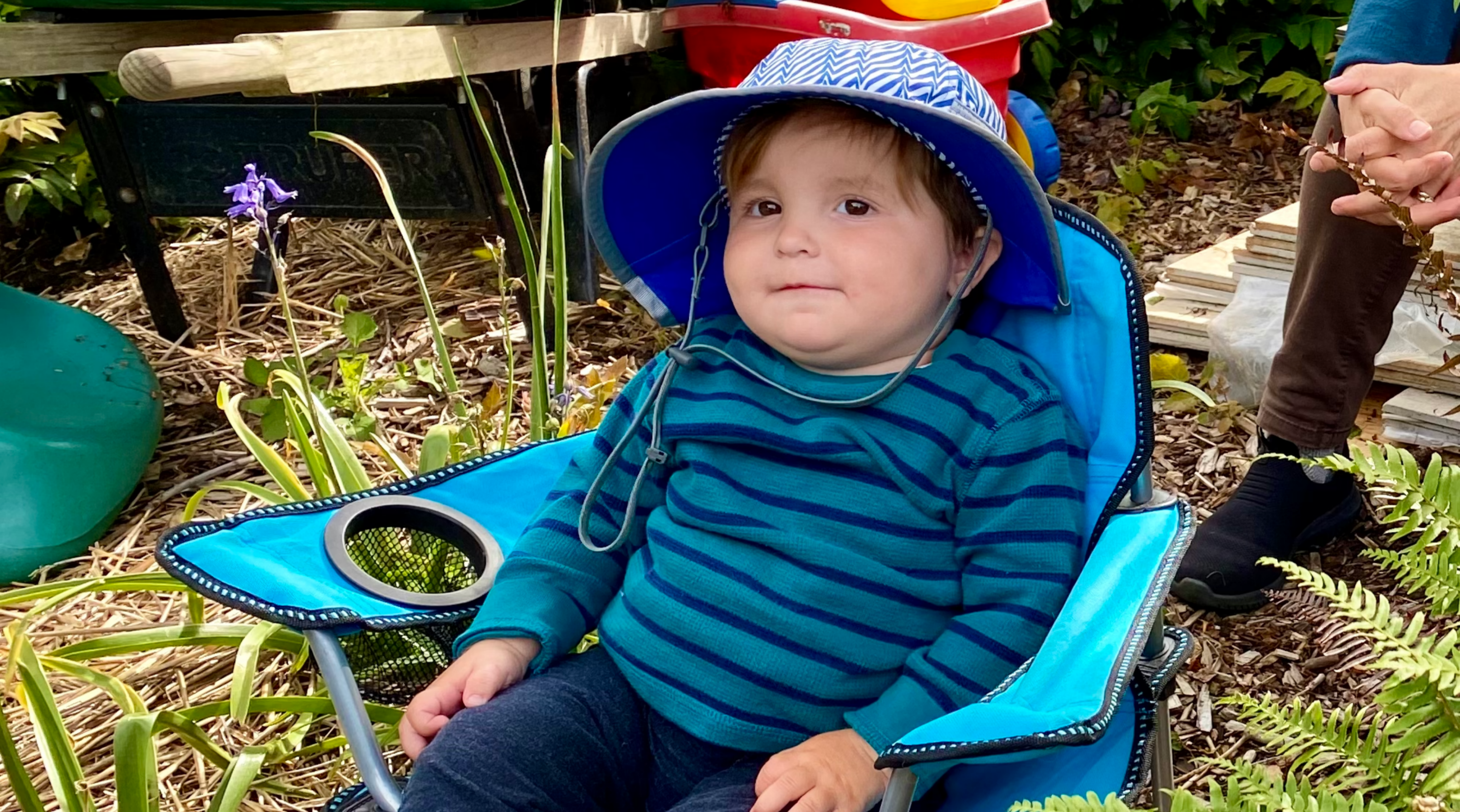I shifted Lucas in my arms, picking up his feeding pump backpack in one hand and a cup of syringes in the other. It was a sunny spring morning and we were headed into our backyard to meet Jane, his occupational therapist. His face lit up with a smile when he saw her walk through the gate. “Hug?” he asked excitedly, waving a tiny arm to punctuate the question.
It was a measure of Jane’s skill that Lucas saw her as a playmate. Her role as a pediatric Occupational Therapist (OT) was more complex. The work of a pediatric OT is to help children improve self-regulation, self-care, and play skills in partnership with their caregivers. If possible, OTs help children reach new developmental milestones.
My son Lucas was unlikely to reach the developmental milestones that show up in a pediatric therapy evaluation. Just after he turned one, he was diagnosed with Leigh Syndrome, a mitochondrial disease and severe neurological disorder. As with other rare neurological disorders, children progressively lose abilities. Currently, there is no treatment or cure.
Shortly after Lucas was diagnosed, his neurologist suggested that exercise could sometimes help slow disease progression in children with a mitochondrial disease like Leigh Syndrome. Given the stark landscape of treatments for Leigh Syndrome, with clinical trials either closed to us or years in the future, exercise was the only proactive treatment. I decided we needed to do all the therapies available.
In the backyard, Jane helped me set up a water table so we could entice Lucas to try standing. I started with Lucas on my lap. Surveying the bobbing toys, his eyes grew wide. Reaching out to splash, he made his signature noise of excitement– “Ahh!”
Adjusting his orthotic braces, we carefully helped him rise to a standing position. He leaned against the water table to support his weight. After playing for a moment, he clenched the edge and started to panic. He couldn’t simultaneously support himself and use his hands to reach for toys. We tried again, but every time we stood him up his face started to crinkle in pain and frustration. He didn’t have the strength to sit down safely on his own.
“Good job, buddy. You are doing so well!” I tried to encourage him. Internally, I was wrestling with my own frustration. I was still so new to the world of rare disease. I didn’t know there were standing frames to help Lucas experience this position securely. I didn’t want to believe that exercising would never stop Leigh Syndrome from advancing. All I knew was that I had so little to offer my child, and I just wanted him to be OK.
I tried to get Lucas back into position, my hands lifting up his reluctant body. Jane gently asked me: “Do you see how hard Lucas is working?” I stared at her, confused. None of the many therapists we worked with had ever described Lucas this way. They said he had a beautiful smile. They said he looked tired. Most often, they told us we just needed to find “the right motivation” for him to make progress.
Jane took over supporting Lucas, talking as she worked. “See how his neck is trembling? He is working hard to hold his head up while he makes the enormous effort of stabilizing his core. When he tries to stand, his knees lock and his entire body trembles. He wants to do what we’re asking, but it is really hard work.”
Something crumpled inside of me as I watched Lucas. He was indeed trembling. What we were asking was beyond his strength. I gathered him back onto my lap, comforting him. Once he recovered he reached for the water table ready to play again.
After Jane left, her words kept reverberating in my mind: “Lucas is working so hard.”
Years ago, I read that play is the essential work of children. It is how they learn, develop, and build relationships. Lucas’s disease and resultant disabilities didn’t change that for him. If he couldn’t engage in therapy, it wasn’t because we had failed to motivate him. The problem was our expectations.
 I had been focused on a world where Lucas battled Leigh Syndrome through exercise and didn’t regress any further, like the stories of families I had found on the internet. Stories that were not ours. Even though I knew my son better than anyone, my desire to fight this cruel disease sometimes blinded me.
I had been focused on a world where Lucas battled Leigh Syndrome through exercise and didn’t regress any further, like the stories of families I had found on the internet. Stories that were not ours. Even though I knew my son better than anyone, my desire to fight this cruel disease sometimes blinded me.
A few weeks later, Lucas would experience a swift and global regression impacting every sphere of his development. Most of the games and activities he enjoyed quickly left his grasp. The water table was only possible if he was carefully supported on our lap, and his erratic arm movements made it less fun.
In the months of progressive loss that followed, we adjusted our expectations over and over. Our goals in therapy adjusted too. We focused on creating moments of joy with Lucas. We worked with his occupational therapist, Jane, to understand each new baseline. We stopped some physical therapy entirely knowing that his energy was precious.
In these months, Lucas had some of the most joyful moments of his life. Jane found a portable chair that could be used in the park, so he could sit with other kids and interact at their level. She brought over giant toy cars outfitted with safety harnesses, so he could feel like he was “driving” around our house. Lucas continued to surprise us all with his capacity for focus and delight, even in the midst of great discomfort.
In some ways, I think Jane’s most important work as an occupational therapist was helping me navigate Lucas’ changing baseline with clarity. It is hard to see clearly when you don’t want to see your child lose their abilities at all. Still, knowing how hard Lucas was working meant we celebrated every tiny win. And therapy became a tool for us to bring Lucas joy, even as his body changed in ways that were hard for us all to bear.
A conversation between Occupational Therapist Jane Witmer and Parent Kim Gilsdorf
During my son Lucas’s life, I often struggled with how many therapy sessions to schedule. There was so much we could do for Lucas. Physical, occupational, feeding, and speech therapies were just the start. Yet nothing we did would fundamentally alter the course of his disease. What should we do?
I know I’m not alone in this struggle. Most Courageous Parents Network families probably take their children to therapies. We do this with love, dedication, and hope. Whether our child has a neurological disorder or another illness, we want to improve the quality and length of their lives. Still, therapy requires a lot of effort and determining what is “helpful” is not easy.
Jane Witmer, my son’s occupational therapist, helped me develop an approach to therapy that acknowledged our uncertainties about what was helpful. We focused on activities that helped Lucas find joy in daily life.
Because Jane was able to help us adjust our approach without ever diminishing Lucas’ potential or strength, I asked if she would reflect with me on how therapists can support children like Lucas and their families. I hope other families and providers find her reflections helpful as they support the children in their lives.
 Kim: Hi Jane – thank you so much for having this conversation with me. Can you start by telling Courageous Parents Network families why you work as a pediatric occupational therapist?
Kim: Hi Jane – thank you so much for having this conversation with me. Can you start by telling Courageous Parents Network families why you work as a pediatric occupational therapist?
Jane: The families! Being an Early Support Specialist (birth to age 3 years) allows me to work just as closely with the caregivers as with the children. I love being able to partner with caregivers and helping them find what is meaningful for them and their family.
Kim: How would you describe the purpose of occupational therapy for a seriously ill child, particularly if they have a neurological disorder like Lucas, and will progressively lose skills?
Jane: The purpose of working as an OT with any child and their family is to meet them where they are and walk alongside them in their journey. The same applies to PT, speech, feeding, and other early support therapies. We bring our expertise in developmental skills like posture, movement, feeding, social interaction, and play. The families bring their love, knowledge, and priorities. Especially with rare conditions, the family typically knows more than the therapist about the condition. We work together to help the child find meaning and joy in their life. The ways that a child with a serious illness finds meaning and joy may look different, but the goals are the same.
Kim: Parents have a wide spectrum of approaches to therapy. Some may not want to engage at all. Others, like me in the early days with Lucas, engage with a level of desperation and hope that may not match the reality of what therapy can deliver. What kinds of conversations should therapists and parents have to build an alliance and develop shared goals?
Jane: Such a great question! The therapist bears a big responsibility in building open communication with the parent and truly listening. We may enter a session with ideas we think will be best, and what turns out to be best for the caregiver or child that day may look very different. By remaining open and really listening or asking what a parent is hoping to get from the session, a therapist can shift the focus to try to meet the need that day. A parent whose child was undergoing unbearable chemotherapy once told me the best thing I ever did was to genuinely smile at their child every time I came. I will never forget that. Any other agenda became less important once I got that feedback.
You, ever the proactive and totally involved parent, surprised me once by letting me know that sometimes, you needed to watch Lucas play and have fun with me. You needed a tiny (and well-deserved) break. I really respected your honesty and was so happy I could help in that small way. Besides, I knew you were watching and learning even though you were “taking a break”. It really helps therapists when parents openly share what their priorities and hopes are. It also helps when parents tell me honestly when I am off track. I so appreciate the parent who says, “That’s a great idea, but I’m not going to do that!” or something similar. I can work with that!
Kim: Sometimes, our medical systems begin to remove therapy time once a child’s baseline begins to decline. What advice would you give families facing this challenge?
Jane: How awful. First, Early Support (sometimes called Early Intervention or Birth to Three services) will continue whether or not insurance will pay. Also, there are some therapy programs like one funded by The Elks in Washington State, that are no cost to families. A hospital social worker should know of programs like these and be able to connect families to them. I would also counsel a family to look to their palliative care team for help with finding therapy support. Additionally, patient advocacy groups often have wonderful resource ideas.
Finally, one does not need to be a therapist to love and play with a child. Seek support from your circle of friends and family to provide plenty of love and play. Children find ways to do their own therapy if allowed to be playful and given access to things they enjoy.
 Kim: I know you were deeply affected when Lucas died, which is a testament to your care for him. How do you care for your own mental health when a child you support dies?
Kim: I know you were deeply affected when Lucas died, which is a testament to your care for him. How do you care for your own mental health when a child you support dies?
Jane: I am so lucky that I work with a wonderful group of people who support each other. I am also lucky that my work provides monthly reflective practice groups where we can process the emotions that occur when doing this work. With Lucas, I was extra lucky because you invited me to share in events to remember and honor him and that helped me so much.
Kim: Can you end by sharing a favorite memory of working with Lucas?
Jane: There are so many! His triumph early on when he figured out he could pull to stand against the fence and push the blocks through the holes. And that we would fetch the blocks for him! I will never forget his enthusiasm for telling us just how to carry out the play activity and the satisfied look he got when we finally got it right.
And the smile that came from his entire being! Mouth, eyes, cheeks, and even chest slightly moving outward when he looked through the window and saw me arriving. Most of all, I loved when he saw me and said “Hug!” It was never a question; it was a command and an expectation.
Jane Witmer is a lead therapist at Wonderland Child and Family Services in Seattle, Washington.
________________________________________________________________________________________________________________
Kim Gilsdorf writes and lives with her family in Seattle, the traditional land of the Duwamish people. She works for Perigee Fund, an organization dedicated to supporting early childhood mental health. Her favorite title is “Mama” to her two children, Lucas and Sophia. Lucas lived with and died from a rare disease, Leigh Syndrome, and his life has forever changed the meaning and purpose of hers. You can find Kim’s writing on Instagram at @kgilsdorf.
